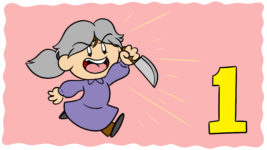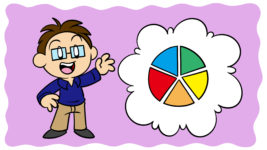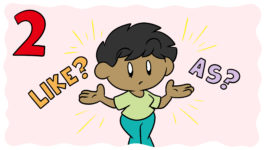In realist writing, villains need to be at least a little relatable (a little sympathetic) in order to be believable. Not all villains have to be sympathetic, of course. Uni-faceted villains can still fill a strong role in the more imaginative or allegorical genres. For instance, we wouldn’t enjoy Edmond Dantès’ epic revenge if Mondego and company were decent chaps who made a few bad choices. But the sympathetic villain can be a powerful tool for carving complexity into character relationships.
Not all antagonists are villains, either. Antagonists are easier to write sympathetically; though they obstruct the protagonist’s path, it is not because they are evil. Their intentions may be more readily justifiable and their ethical status in the book might be similar to that of the protagonist. The antagonistic duo in A Passage to India illustrate this idea brilliantly, as the narrator alternates perspectives to equitably represent both characters. Simply put: antagonists aren’t necessarily bad people. Villains are. Or, at least, that’s how they’re represented.
So today, we’re looking at villains (more bad than good, at least as they are represented in the current story), and sympathy. Sympathy isn’t ‘feeling sorry for,’ though it could include this. From the Greek, it is feeling (pathy) with (sym). In short, sympathetic villains cause readers to feel, yielding multifaceted and memorable characters… and therefore books.
It’s a high bar to clear, so how do you make your villains sympathetic?
Make them attractive
People said of Ted Bundy that he was charming, unassuming, handsome – the complete opposite of what you might picture if you read his rap sheet and never heard that Adam Long would be portraying him on a Netflix series circa 2018. He was so disturbingly appealing that people at the trial were saying things like, “Are you sure you have the right guy?”
The average person might be embarrassed to admit they’re intrigued by Ted Bundy. That doesn’t slake the intrigue, though. Why? What is it about the chilling synthesis of charisma and perversity that makes it hard for people to tear themselves away?
There’s a slew of literature on human fascination with villains, and I touch on some of it here. The key to understanding sympathetic villains for today’s purposes, though, lies in understanding what causes a reader to feel for a villain.
In the case of real-life serial killer Ted Bundy, I’d argue that people are fascinated because they are wondering if they would have been duped, too. Bundy’s attractive qualities are the very qualities that enabled his savagery. He seemed so normal, so amiable, so handsome. Would I have trusted him? Would I have been one of his victims? Though it’s a disturbing thought, it’s a sympathetic one. It thrusts the thinker, fully emotive, into the story.
Watch it happen in literary representations: Patrick Bateman, Carmilla, the Phantom of the Opera, James Moriarty, all pirates ever. Whether because they are sexy (the first two), enthralling (the Phantom), brilliant (Moriarty), or romanticized (pirates), the magnetism of these villains is in the reader’s wonderment: how would it feel to be wooed by the angel of music? How would it feel to engage in a battle of wits with the mind that put Holmes himself to the test? How would it feel to dabble in the ‘glamour [of] the pirate calling’ (so wonder John and Michael in Peter Pan)?
If the reader is not sympathetic, they are more likely repulsed or disinterested. Though the villains in The Count of Monte Cristo, as mentioned above, create a powerful platform for Dantès’ revenge, they don’t have the same memorability as Captain Hook. In fact, they are more platform than character.
Thus a villain who is attractive in some capacity will have a twisted sort of appeal – not one that causes your readers to root for the villain, but one that makes it impossible for them to forget your villain. When readers feel a character, they remember.
A compelling villain attracts the reader, engendering sympathy.Click To TweetMake it happen: Choose one or two ways in which your villain will excel – they might be unbearably good looking, sexy and mysterious, charismatic, super intelligent, or ideologically passionate. Make it appealing enough that the reader’s scales just barely tip in an unfavorable direction, then play with that balance according to your stories’ needs.
Develop them (all the way)
If you want your villains to be full-on characters rather than plot devices (not necessarily a bad thing), they need to be fully developed. Just like your heroes, they need a goal, a voice, history, friends, jobs, hobbies, foods they don’t like, and so on.
Though we could hardly take a liking to Claude Frollo, his character is more than a device for orchestrating tragedy. He’s quite complex: he’s an orphan, he’s intelligent and (tries to be) devout, he makes his way through his own hard work, he is misjudged by the townspeople, his brother’s an alcoholic, he adopts and takes care of a deformed kid… and he’s conflicted. His chosen station in life keeps him celibate – a seemingly good choice until Esméralda comes along and Claude Frollo assumes his place as the story’s villain.
If you read the book and watch the Disney adaptation back-to-back, you’ll have a vibrant illustration of the difference between a sympathetic villain and a plot device. When the hero and the villain are both fully developed, they are more of an even match, and the battle between them becomes much richer. In some cases, such as in Tolstoy’s War and Peace or Nabokov’s Lolita, readers become so intimately acquainted with the villain, they forget for a while that they are the villain. If you accomplish this degree of character development, you will find yourself with a pretty unforgettable antihero.
Develop your villain just as you would any other character.Click To TweetMake it happen: The character’s situation or history can strongly support their development. Though the tragic back story is cliché, it is still effective. Consider circumstances beyond a character’s control (Frankenstein’s monster or Lennie Small), crippling social prejudice (anti-Semitism in The Merchant of Venice or sexism in The Handmaid’s Tale), broken friendships (Clark Kent and Lex Luthor), and other complexities that will add believability to your villains.
Justify them (at least partially)
If you have a totally justified villain, you don’t have a villain; you have an antagonist. When a villain has a thread of moral strength, though, they layer intricacy and sympathy onto the story.
Javert, in his relentless pursuit of Valjean in Les Miserables, is essentially doing what he believes to be right. He has a reverence for and devotion to protecting society. He takes it too far, and in the end commits an act of treachery that pushes him across the line from antagonist to villain, but not before readers develop a certain respect for him, even hoping he can be redeemed. They don’t get their wish, but semi-justifiable villains often do become redeemed villains (Darth Vader chief among them), and that’s another take on this angle.
Villains that we vindicate (or want to vindicate) may also have moments of goodness that, while all-too-fleeting, endear them to readers. Margaret Atwood’s Serena Joy is clearly identifiable as a villain, and much of her behavior is utterly inexcusable, but she’s also a victim. Readers have just begun to feel sorry for her when she turns around and does something terrible, and this repeats itself again and again. Her gestures of kindness toward Offred are just manipulative enough that the reader is caught in a cycle of despising her and wishing for her redemption, much as they hope for Javert’s.
The connection a reader forges with Serena is derived from a sense of almost-pity, but it runs deeper than that: because Serena so passionately believed that her choices, everything she fought for, would make the world a better place, the stark contrast between reality and good intentions is drawn.
What good intentions fuel your villain? Which other characters see their good side?Click To TweetMost people have good intentions. Some choices are misguided, most people make misguided choices, but most are also lucky enough that their poor choices do not have lasting ramifications for all of society. Serena’s choices have terrible consequences for society, and she exacerbates those consequences through her cruelty toward Offred (thus solidifying her role as a villain), but the consequences for her are terrible as well. Instead of gender equity, things are worse than they ever were. Her marriage is in shambles. She can’t have the baby she so desperately desires. Her husband has sex with another woman in her presence. She’s submerged in a world of fear and pretense and powerlessness. The reader grapples: under the wrong circumstances, would I respond any better than she?
Make it happen: Everyone, in life and in literature, is their own protagonist. Play around with your villain for a while, treating them as though they were your hero. Discern their emotions, motivations, and good intentions. Give them at least one supporting character to reinforce the reader’s ability to connect on an emotional level (see Frodo’s sympathy for Gollum.) Try being the villain’s mother for a day. What would she say in defense of her son or daughter? For a simple start, find some moments where your villain can pet the dog.
The bottom line: make them human
To write villains your readers can view sympathetically, write villains that are human. Help your readers see the I’m-human-too side of these characters – the side that appeals to people, the side that hurts, and loves, and cries at Rachmaninoff, and hates the smell of latex, and takes the kids swimming in the summer, and slices up bananas for their cereal with a paring knife, and laughs at Frasier, and can’t afford a nice car, and grew up with a bunch of bullies, and feels guilty for stealing office supplies from work. Humans, at their best, sympathize with other humans. They may still ultimately reject them – as villains or, in most people’s cases, simply as annoying – but first they felt them. They felt a yearning, a desire for redemption. The tragedy of hopes raised and dashed won’t leave your reader any time soon.
There are many unforgettable villains I haven’t named here. Who are your favorites, and what makes a reader sympathetic toward them? Let me know in the comments, and check out How To Make The Reader Trust Your Villain, The Two Secrets To Writing A First Rate Villain, and The Best Ways To Root Out A Cheesy Villain for more great advice on this subject.






6 thoughts on “How To Write A Sympathetic Villain”
Hello, Rebecca!
I am sixteen years old and have recently discovered Standout Books to help me with writing my first book. These articles (of which I’ve read dozens) are so, so, so helpful!! You and the other incredibly talented editors who contribute to this blog have guided me beyond belief, and I am eternally grateful. I cannot wait to keep reading what you publish here!
Yours,
Juliana
Hi, Juliana.
Thank you so much for your kind words! I’m so happy to hear that you have found our website to be supportive of your efforts. I wish you the best of luck in writing your book as well. Keep in touch and let us know if you need anything, or if there’s anything you want to read about that we haven’t written about.
Best wishes,
Rebecca Langley
Thanks for reminding us that antagonists are not always monsters that can’t be rehabbed. I like my antagonists to be human,and even though they’re playing the role of a villain, they’re someone’s son or daughter, and beneath their thorny exterior a good person is waiting to emerge. Most of my antagonists are villainous because they’ve been deceived in the past.
Hi, Linda.
Great observation. I believe real life antagonists are the way they are because of past hurts. As a mother, I’ve often wondered about their mothers–the good things they know about their children. Sounds like you’ve got a good habit of humanizing your villains.
Thanks for chiming in, and best wishes,
Rebecca Langley
Thanks for the informative and helpful article. Hannibal Lector would illustrate a few of your points. He’s brilliant and erudite in a number of ways, but he also grew up as an orphan. With villains, I think they tap into a part of our psyches where we can identify to a certain extent with some of their human frailties and they also make us question some of our own extreme feelings. In a cloudburst of anger, everyone has thought about killing or hurting that horrible boss or unfaithful lover, haven’t we? The villains live out these fantasies for us.
Hi, Jim.
That’s an excellent point – literary villains are a sane and safe outlet for feelings we can’t (most of us) act upon.
There may also be a twisted sense of justification that we derive from their backstories; if we understand where a villain is coming from, we almost feel a sense of satisfaction. Maybe it’s because we don’t want villains to be monsters. I recall when the public consciousness learned that Hitler had been rejected from art school – everybody latched on to that story and retold it with such empathy, as this story humanized him in a way people seemed to be waiting for. How can we make sense of a character like Hannibal Lecter if he WASN’T an orphan (or something)?
Thanks for adding to the conversation,
Rebecca